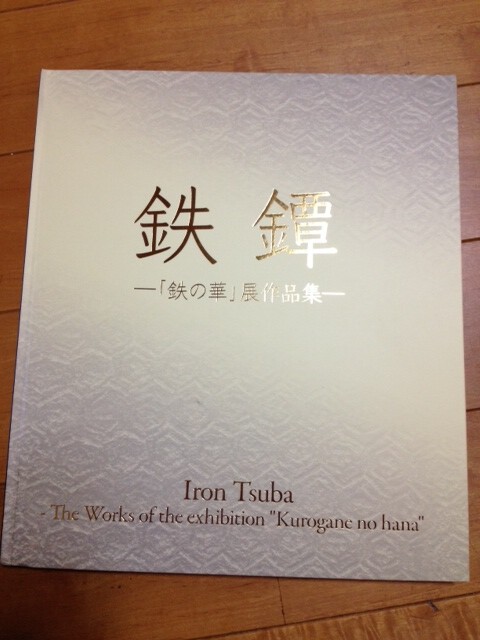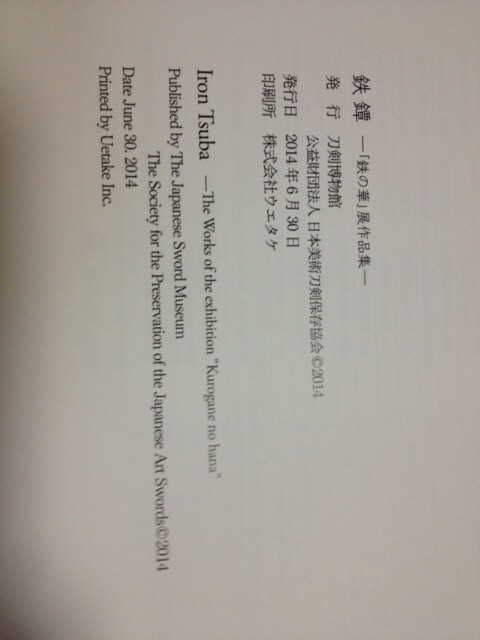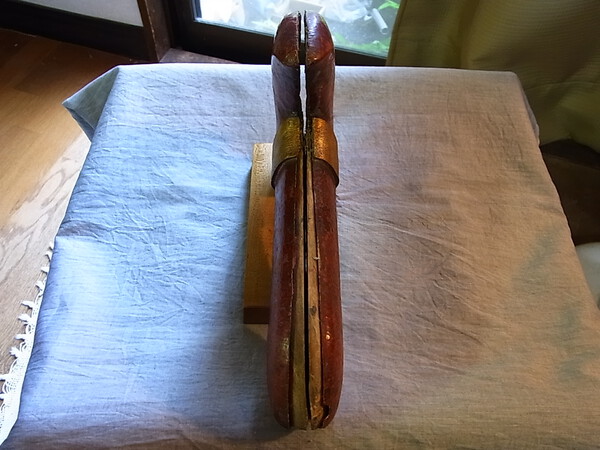-
Posts
14,118 -
Joined
-
Last visited
-
Days Won
263
Content Type
Profiles
Forums
Events
Store
Downloads
Gallery
Everything posted by Bugyotsuji
-
At the Bakumatsu end of time, Mon were being created by everyone and his brother, so this one could really be anything. As to the signature, it comes from a long and respected line of Kunitomo gunsmiths, Kunitomo Tokuro, based in Kunitomo, but also with individuals working for other Han, such as 志筑藩 in 常陸国 (Hitachi) and 小浜藩 in 若狭国 (Wakasa).
-
Markus. The only copy I have seen belongs to a friend. I will try and get round there tomorrow. A bit drunk on Saturday night when I flicked thru it the second time, but there was only one non-Japanese name in the credits, a collector with a name I did not recognize. Watch this space. Not really wanting to rock the boat either on the Japanese or Western side here. Will get that scan for you.
-
You are correct, Isidro.
-
They seem fairly close... http://www.bing.com/images/search?q=ayu ... 8&sp=1&sk=
-
Anything like this? http://www2.edu.ipa.go.jp/gz/c1part/c1g ... /c1et8.jpg
-

Woodblock print with matchlocks!
Bugyotsuji replied to Viper6924's topic in Tanegashima / Teppo / Hinawajū
Competitions? Ah, no, I meant competition with you for scarce resources! Tomorrow I have to go to Himeji for the joint Kantei where they will have something like 38 Sue Bizen blades to the members to wrassle with, and the drunken group grope afterwards. Well, dinner and a stayover to sleep off the hangover. -

Woodblock print with matchlocks!
Bugyotsuji replied to Viper6924's topic in Tanegashima / Teppo / Hinawajū
Jan, you are starting to sound like Takeda Shingen above!!! What do you have in common? Do I sense extra meaning behind your words, I wonder? :lol: The prints that I showed have mostly made their way onto Eric's Pinterest site. Maybe a link to there would be the best short-cut. In the meantime, I'll dig some up after the weekend! (Got competiton now.... grrr........) -
Whoah! Hold your horses! My fault for the way I expressed myself above, for which I apologize. To clarify, the local members of our sword society here in the backwoods of Japan are contemplating a bulk order. As I said in the first post, I do not know if or when these are going on sale if they have not already, I am not sure what the exact price will be, although 2,500 yen is rumored, and I was warned that the ordering process may be old-fashioned fax/phone-type clunky. :|
-

Woodblock print with matchlocks!
Bugyotsuji replied to Viper6924's topic in Tanegashima / Teppo / Hinawajū
Some nice examples, Jan, tying art, history and the Tanegashima-style Hinawa-Ju matchlock together. Are yours framed and on the walls, or in a folder? BTW Great idea to start a dedicated thread on matchlock woodblock prints. *I have shown most of mine somewhere on this site already, not that I have many, and they tend not to be in very good condition as good ones can cost a small fortune. -
At last year's NBTHK weekend, (the same weekend as the DTI) there was a magnificent collection of Tsuba brought together in one room at the HQ, and there were many voices requesting a photographic publication to take advantage of that singular chance. It seems that just such a book has now been printed in a limited run of 1,000 copies. "鉄鐔 Iron Tsuba, The Works of the Exhibition: Kurogane no Hana". 30 June 2014. They will be 2,500 yen each I believe.Whether it has actually officially gone on sale yet, I am not sure, but I had a quick look at a copy yesterday and placed an order, well, sort of raised my hand eagerly. It seems to have good representative examples of various schools (Nobuie, Kaneie etc.) not normally seen in public. Since many of the requests were from overseas members, the whole book is done fully in both Japanese and English. Ordering may be a problem as they will probably use fax and telephone, with payment to be wired. (Our members here are working on a bulk order to facilitate the process.)
-

Taira Sawada's book "Nihon no Furuju"
Bugyotsuji replied to estcrh's topic in Tanegashima / Teppo / Hinawajū
Thanks Piers, any idea of the original date this book was published? Eric, the publication date is not mentioned. His books come off the press of a private study group. No ISBN that I can see. The author signs his afterword with Heisei 7, May. (1995) -
Hair? Fur? Fuzz? Came up in conversation the other day and to my shame I realized that Uesugi Kenshin's famous Ichimonji was/is in a local museum, and I had never seen it or even heard of it. https://www.google.com/search?q=%E5%B1% ... 80&bih=685
-

Jumonji yari, Fukuoka Moritsugu, Enpo Shinto
Bugyotsuji replied to Bugyotsuji's topic in General Nihonto Related Discussion
Yesterday I was visiting a dealer in a different prefecture and having a gander at what he had salted away. Imagine my surprise to find a Jumonji Yari Saya, covered in fine red leather! I bought it on the spot. That is the the good news. (I really did not like the sheath that had come with it on the original Koshirae, and this seemed to be a golden chance, too good to pass up.) The bad news is that it is filthy, cracked completely open, the wrong size, and the leather is badly shrunk. :| We pushed a length of wire up the inside and it has about 20 cm of room in there. The cross-pieces look too small. Like Cinderella's ugly sisters though, I am going to force that glass slipper onto my foot whatever it takes. Today I am planning to ask the Saya-maker for a quote on refurbishment of the sheath, both externally and internally, to fit comfortably onto the spear head. The fact that it is already split into two may make his job easier. Watch this space?! -
In defense/defence of Justin, I know he has been putting his mind and energies to learning Japanese, and also Japanese terminology for J armor/armour, guns etc. I know he feels like he is banging his head against the wall much of the time and I have attempted to encourage him in his pursuit, because he has come so far. I have failed in suggesting such a refinement to him. It is entirely possible that I myself have been guilty of what Ron says above. If so I apologize. May I add that it was never my intention to do so, but it is possible that I have used terminology like that forgetting to provide the English alongside. I have a golden rule that when using a word that people might not know, in all of the spoken and written translation that I do, I provide the English too. Even as I write this my ears are burning as I become sure that I must have broken this rule on many an occasion. It is never translation if a barrier is left standing. A serpentine is a 'serpentine', or a 'Hibasami serpentine'. I do believe however that it is an advantage to know both sets of words, and in some cases there is no fixed English equivalent. I also make it my business to use a word that people are not familiar with slightly more often to draw attention to it. "Is 'Tanegashima' really the correct word?" many people ask me. Well, the answer depends on the situation, as Ron says. In Japanese, it isn't. In my writings here and there I will often allude to a "Tanegashima-style Hinawa-Ju Japanese matchlock", and this is an attempt to help fix the most common and formal Japanese word for it, ie 'Hinawa-Ju' (match-gun) into Western people's minds. It also follows the Japanese habit of talking about such guns in a supplementary way as 'Tanegashima-style' to jog the J layman's understanding of what is being discussed. Ron, thank you for bringing this up.
-
Some light reading here. http://www.toptenz.net/top-10-famous-de ... ords.php/2 Incidentally I have a Japanese friend who has spent half his life trawling through the countries of SE Asia looking for forgotten Japanese swords. He says if there are any still out there, they have been missed by the hundreds of people following the same trails of talk and rumors/rumours.
-

Cutting test Katana with extra long Nagasa
Bugyotsuji replied to Nickupero's topic in For Sale or Trade
Surely we could do a better job of translating the kingin zogan Mei. -

Jumonji yari, Fukuoka Moritsugu, Enpo Shinto
Bugyotsuji replied to Bugyotsuji's topic in General Nihonto Related Discussion
Thanks Ken. To be honest, it is not quite what I was expecting, but I hope it helps towards preservation of a Japanese artifact for future generations. -

Jumonji yari, Fukuoka Moritsugu, Enpo Shinto
Bugyotsuji replied to Bugyotsuji's topic in General Nihonto Related Discussion
The phone rang. My NBTHK teacher to say it was ready. (1:00 pm Tuesday) "Bbbut, ...surely he only received it around midday yesterday!!!" I shouted down the phone. "How could he have possibly finished it in less than 24 hours?" It does look a bit Aztec, but it does the job; the two locking pieces push into place, and depend upon the head of the Mekugi facing up, to line up with a little black spot on the saya. Material: Ho-no-Ki. The tips of the elbows are concave and push against the base of the Kerakubi. -

Kayaku-dameshi (Gunpowder tester)
Bugyotsuji replied to Viper6924's topic in Tanegashima / Teppo / Hinawajū
My gut instinct tells me that Ron is right. Incidentally the bottom of those 2 pics above shows two holes in the spine, yes, but one is not the touch-hole. It is a vertical chimney that transverses the tail, possibly for fixing/pinning the thing in some way. The hole in front of that communicates into the barrel. That one belongs to a certain Mr O, and I took that picture. The little one above it with regular touch-hole is mine. With no evidence of exact measuring equipment, according to Ian B, we cannot really even be sure that these were eprouvettes in the western sense. Knowing the Japanese, though, I can imagine them testing gunpowder in the hand by feel, by sound, by flash... considering the way one of them can come up to me after a half-hour of 20 gunners' live firing and comment on the great sound that my gun made today! -

Jumonji yari, Fukuoka Moritsugu, Enpo Shinto
Bugyotsuji replied to Bugyotsuji's topic in General Nihonto Related Discussion
At my Kantei sword meeting the other night I asked if someone could make air-lockout sections for the bottom of the Jumonji Saya. Thankfully they found me a professional who will do the work for peanuts, so I placed the order forthwith. Suffice it to say I will get plenty of change out of 100 USD. My sword teacher has been reading up on the usage of clove oil and mineral oil and handed out a pretty good print on the different usages and the dangers inherent with each. When I said Enpo smith for Moritsugu I was told by one elderly member very firmly, "no, Jokyo" (1684-1688)... -
If you need to read that badly scribbled Mei notation, it would help the members if you could show: a) the Nakago bearing the original Mei 弘秀 Hirohide? b) a photo of the paper out of its cover. There seems to be some *information top left in pencil which might help towards solving your puzzle, when compared with your Nakago. *Hirohide, 広秀 Hiromoto広元 同人 same person... Gifu...Mutsu











